Impact of Delayed Artificial Aging on Tensile Properties and Microstructural Evolution of Directed Energy Deposited Scalmalloy®
Abstract
1. Introduction
2. Materials and Methods
2.1. AM Fabrication
2.2. Natural Aging and Artificial Aging Treatments
2.3. Microstructural Evolution and Mechanical Property Characterization
3. Results
3.1. Tensile Properties
3.2. Microstructural Characterization
4. Discussion
4.1. Heat Treatments and the Impact of Microstructure Evolution on Tensile Behavior
4.2. Natural Aging, Nanoprecipitation, and the Impact on Tensile Behavior
5. Conclusions
- Application of natural aging time is seen to result in decreased tensile strength. After 6 days of natural aging prior to artificial aging (6 NA), the average YS and TS are diminished by 10 and 8.6%, respectively. As natural aging time increases to 12 days (12 NA), average YS decreases by 23%, and TS decreases by 18% relative to the 0 NA case. Additionally, an overall diminishing trend was noted for elongation after fracture with the application of natural aging.
- Accompanying the decreases in YS and TS as natural aging time increases is the increase in median nanoprecipitate size (Feret diameter) by 26% after 6 days (6 NA) and 73% at 12 days (12 NA) relative to 0 days of natural aging (0 NA). With the increase in precipitate size, it was also noted that the number of precipitates was decreased, with precipitate area fractions for 0 NA, 6 NA, and 12 NA being 1.2, 1.1, and 0.74%, respectively. The increased size and decreased number of precipitates negatively impact the ability to precipitate strengthen and can be linked to the decrease in YS and TS.
- Like the nanoprecipitates, the Al3(Sc,Zr) micron and sub-micron phase particles experienced a size increase with natural aging. The particle size increased by 58% after 12 days at room temperature (12 NA) relative to 0 days of natural aging (0 NA). With the increase in size, it was noted that the number of particles decreased, likely due to growth at the expense of others. The increased size and decreased number of secondary Al3(Sc,Zr) phase particles limit strengthening capabilities.
- Along with the evolution of precipitates, the microstructure demonstrated increased grain sizes with increasing natural aging time. Of note is the dramatic increase in grain size for 12 NA compared to 0 NA and 6 NA. The increased grain size is theorized to be a key piece of the explanation behind the initial decrease in YS and TS seen on days 2–10, and the further decrease occurs on 12 NA. The increasing grain sizes mean that the number of grains and grain boundaries is decreased. As a result, the Hall-Petch or grain boundary strengthening is negatively impacted and can be linked to the decreased YS and TS.
- From the results of this study, cases where natural aging can be eliminated, and artificial aging can proceed immediately following fabrication are vastly preferable. However, if natural aging is unavoidable, the time frame for DED Scalmalloy® components should be constrained to time frames less than 12 days (12 NA).
- Future Work: The impact of natural aging on tensile strength has been well documented for conventional processing of select common aluminum alloys; however, the lack of literature surrounding the impact on AM aluminum leaves a considerable gap in the knowledge base. The knowledge gap stems from the fact that, in most cases, it is impossible to eliminate any natural aging time between fabrication and artificial aging. As a result, it is necessary to understand how delaying artificial aging treatments impacts behavior so that a solution can be found to address and balance the issue of property diminishment while allowing for a waiting period between fabrication and artificial aging. These studies should also be expanded to document additional causal behavior observed as an effect of natural aging with an emphasis on minimizing any adverse mechanical performance due to natural aging. Future studies are recommended to document this behavior in other aluminum alloys used in AM.
Author Contributions
Funding
Institutional Review Board Statement
Informed Consent Statement
Data Availability Statement
Acknowledgments
Conflicts of Interest
Abbreviations
| AM | Additive Manufacturing |
| DED | Directed Energy Deposition |
| DMD | Direct Metal Deposition |
| DMLM | Direct Metal Laser Melting |
| DMLS | Direct Metal Laser Sintering |
| EBSD | Electron Backscatter Diffraction |
| EDM | Electrical Discharge Machine |
| EDS | Energy Dispersive Spectroscopy |
| LENS | Laser-Engineered Net Shaping |
| LPBF | Laser Powder Bed Fusion |
| NA | Natural Aging |
| SEM | Scanning Electron Microscopy |
| SLM | Selective Laser Melting |
| SSSS | Supersaturated Solid Solution |
| TS | Tensile Strength |
| TFS | Thermo Fisher Scientific |
| YS | Yield Strength |
References
- Riveiro, A.; del Val, J.; Comesaña, R.; Lusquiños, F.; Quintero, F.; Boutinguiza, M.; Pou, J. Laser Additive Manufacturing Processes for Near Net Shape Components. In Near Net Shape Manufacturing Processes; Gupta, K., Ed.; Springer International Publishing: Cham, Switzerland, 2019; pp. 105–141. ISBN 978-3-030-10579-2. [Google Scholar]
- Mehrpouya, M.; Vosooghnia, A.; Dehghanghadikolaei, A.; Fotovvati, B. The benefits of additive manufacturing for sustainable design and production. In Handbooks in Advanced Manufacturing; Gupta, K., Salonitis, K., Davim, P.J., Eds.; Elsevier: Amsterdam, The Netherlands, 2021; pp. 29–59. ISBN 978-0-12-818115-7. [Google Scholar]
- Cicconi, P.; Mandolini, M.; Favi, C.; Campi, F.; Germani, M. Metal Additive Manufacturing for the Rapid Prototyping of Shaped Parts: A Case Study. Comput. Aided. Des. Appl. 2021, 18, 1061–1079. [Google Scholar] [CrossRef]
- Martof, A.; Gullapalli, R.; Kelly, J.; Rea, A.; Lamoncha, B.; Walker, J.; Conner, B.; Macdonald, E. Economies of Complexity of 3D Printed Sand Molds for Casting. In Proceedings of the Solid Freeform Fabrication Symposium, Austin, TX, USA, 13–15 August 2018. [Google Scholar]
- Liou, F.W. Rapid Prototyping and Engineering Applications: A Toolbox for Prototype Development, 2nd ed.; Taylor and Francis: Abingdon upon Thames, UK; CRC Press: Boca Raton, FL, USA, 2019; ISBN 9780429029721. [Google Scholar]
- Lynch, P.; Hasbrouck, C.R.; Wilck, J.; Kay, M.; Manogharan, G. Challenges and opportunities to integrate the oldest and newest manufacturing processes: Metal casting and additive manufacturing. Rapid Prototyp. J. 2020, 26, 1145–1154. [Google Scholar] [CrossRef]
- Vafadar, A.; Guzzomi, F.; Rassau, A.; Hayward, K. Advances in Metal Additive Manufacturing: A Review of Common Processes, Industrial Applications, and Current Challenges. Appl. Sci. 2021, 11, 1213. [Google Scholar] [CrossRef]
- Armstrong, M.; Mehrabi, H.; Naveed, N. An overview of modern metal additive manufacturing technology. J. Manuf. Process. 2022, 84, 1001–1029. [Google Scholar] [CrossRef]
- Tshephe, T.S.; Akinwamide, S.O.; Olevsky, E.; Olubambi, P.A. Additive manufacturing of titanium-based alloys—A review of methods, properties, challenges, and prospects. Heliyon 2022, 8, e09041. [Google Scholar] [CrossRef] [PubMed]
- Fleißner-Rieger, C.; Pfeifer, T.; Turk, C.; Clemens, H. Optimization of the Post-Process Heat Treatment Strategy for a Near-α Titanium Base Alloy Produced by Laser Powder Bed Fusion. Materials 2022, 15, 1032. [Google Scholar] [CrossRef]
- Wan, H.; Wang, Q.; Lin, H. The effect of lack-of-fusion porosity on fatigue behavior of additive manufactured titanium alloy. Key Eng. Mater. 2017, 723, 44–50. [Google Scholar] [CrossRef]
- Zhang, D.; Qiu, D.; Gibson, M.A.; Zheng, Y.; Fraser, H.L.; StJohn, D.H.; Easton, M.A. Additive manufacturing of ultrafine-grained high-strength titanium alloys. Nature 2019, 576, 91–95. [Google Scholar] [CrossRef]
- Sun, Z.; Tan, X.; Tor, S.B.; Chua, C.K. Simultaneously enhanced strength and ductility for 3D-printed stainless steel 316L by selective laser melting. NPG Asia Mater. 2018, 10, 127–136. [Google Scholar] [CrossRef]
- Wang, Y.M.; Voisin, T.; McKeown, J.T.; Ye, J.; Calta, N.P.; Li, Z.; Zeng, Z.; Zhang, Y.; Chen, W.; Roehling, T.T.; et al. Additively manufactured hierarchical stainless steels with high strength and ductility. Nat. Mater. 2018, 17, 63–71. [Google Scholar] [CrossRef]
- Riemer, A.; Leuders, S.; Thöne, M.; Richard, H.A.; Tröster, T.; Niendorf, T. On the fatigue crack growth behavior in 316 L stainless steel manufactured by selective laser melting. Eng. Fract. Mech. 2014, 120, 15–25. [Google Scholar] [CrossRef]
- Haghdadi, N.; Laleh, M.; Moyle, M.; Primig, S. Additive manufacturing of steels: A review of achievements and challenges. J. Mater. Sci. 2021, 56, 64–107. [Google Scholar] [CrossRef]
- Biffi, C.A.; Fiocchi, J.; Tuissi, A. Selective laser melting of AlSi10 Mg: Influence of process parameters on Mg2Si precipitation and Si spheroidization. J. Alloys Compd. 2018, 755, 100–107. [Google Scholar] [CrossRef]
- Dinda, G.P.; Dasgupta, A.K.; Mazumder, J. Evolution of microstructure in laser deposited Al–11.28%Si alloy. Surf. Coat. Technol. 2012, 206, 2152–2160. [Google Scholar] [CrossRef]
- Schmidtke, K.; Palm, F.; Hawkins, A.; Emmelmann, C. Process and Mechanical Properties: Applicability of a Scandium modified Al-alloy for Laser Additive Manufacturing. Phys. Procedia 2011, 12, 369–374. [Google Scholar] [CrossRef]
- Muhammad, M.; Nezhadfar, P.D.; Thompson, S.; Saharan, A.; Phan, N.; Shamsaei, N. A comparative investigation on the microstructure and mechanical properties of additively manufactured aluminum alloys. Int. J. Fatigue 2021, 146, 106165. [Google Scholar] [CrossRef]
- Feister, T.; Kim, H.; Gwinn, A.; Schiller, T.; Austin, M. Failure predictions in warm forming of 7075-T6 aluminum structural parts. IOP Conf. Ser. Mater. Sci. Eng. 2018, 418, 12024. [Google Scholar] [CrossRef]
- Fridlyander, I.N.; Dobromyslov, A.V.; Tkachenko, E.A.; Senatorova, O.G. Advanced High-Strength Aluminum-Base Materials. Met. Sci. Heat Treat. 2005, 47, 269–275. [Google Scholar] [CrossRef]
- Altıparmak, S.C.; Yardley, V.A.; Shi, Z.; Lin, J. Challenges in additive manufacturing of high-strength aluminium alloys and current developments in hybrid additive manufacturing. Int. J. Light. Mater. Manuf. 2021, 4, 246–261. [Google Scholar] [CrossRef]
- Martin, J.H.; Yahata, B.D.; Hundley, J.M.; Mayer, J.A.; Schaedler, T.A.; Pollock, T.M. 3D printing of high-strength aluminium alloys. Nature 2017, 549, 365. [Google Scholar] [CrossRef]
- Rometsch, P.A.; Zhu, Y.; Wu, X.; Huang, A. Review of high-strength aluminium alloys for additive manufacturing by laser powder bed fusion. Mater. Des. 2022, 219, 110779. [Google Scholar] [CrossRef]
- Koutny, D.; Palousek, D.; Pantelejev, L.; Hoeller, C.; Pichler, R.; Tesicky, L.; Kaiser, J. Influence of Scanning Strategies on Processing of Aluminum Alloy EN AW 2618 Using Selective Laser Melting. Materials 2018, 11, 298. [Google Scholar] [CrossRef] [PubMed]
- Kaufmann, N.; Imran, M.; Wischeropp, T.M.; Emmelmann, C.; Siddique, S.; Walther, F. Influence of process parameters on the quality of aluminium alloy EN AW 7075 using selective laser melting (SLM). Phys. Procedia 2016, 83, 918–926. [Google Scholar] [CrossRef]
- Zhou, L.; Hyer, H.; Park, S.; Pan, H.; Bai, Y.; Rice, K.P.; Sohn, Y. Microstructure and mechanical properties of Zr-modified aluminum alloy 5083 manufactured by laser powder bed fusion. Addit. Manuf. 2019, 28, 485–496. [Google Scholar] [CrossRef]
- Aversa, A.; Marchese, G.; Saboori, A.; Bassini, E.; Manfredi, D.; Biamino, S.; Ugues, D.; Fino, P.; Lombardi, M. New Aluminum Alloys Specifically Designed for Laser Powder Bed Fusion: A Review. Materials 2019, 12, 1007. [Google Scholar] [CrossRef]
- Awd, M.; Tenkamp, J.; Hirtler, M.; Siddique, S.; Bambach, M.; Walther, F. Comparison of Microstructure and Mechanical Properties of Scalmalloy® Produced by Selective Laser Melting and Laser Metal Deposition. Materials 2017, 11, 17. [Google Scholar] [CrossRef]
- Boillat-Newport, R.; Isanaka, S.P.; Kelley, J.; Liou, F. Heat Treatments for Minimization of Residual Stresses and Maximization of Tensile Strengths of Scalmalloy® Processed via Directed Energy Deposition. Materials 2024, 17, 1333. [Google Scholar] [CrossRef]
- Babuska, T.F.; Krick, B.A.; Susan, D.F.; Kustas, A.B. Comparison of powder bed fusion and directed energy deposition for tailoring mechanical properties of traditionally brittle alloys. Manuf. Lett. 2021, 28, 30–34. [Google Scholar] [CrossRef]
- Cabrera-Correa, L.; González-Rovira, L.; de Dios López-Castro, J.; Castillo-Rodríguez, M.; Botana, F.J. Effect of the heat treatment on the mechanical properties and microstructure of Scalmalloy® manufactured by Selective Laser Melting (SLM) under certified conditions. Mater. Charact. 2023, 196, 112549. [Google Scholar] [CrossRef]
- Carpenter Additive Scalmalloy Datasheet. Available online: https://www.carpenteradditive.com/hubfs/Resources/Data%20Sheets/Scalmalloy_Datasheet.pdf (accessed on 6 June 2024).
- Kuo, C.N.; Peng, P.C.; Liu, D.H.; Chao, C.Y. Microstructure evolution and mechanical property response of 3d-printed scalmalloy with different heat-treatment times at 325 °C. Metals 2021, 11, 555. [Google Scholar] [CrossRef]
- Baig, S.; Ghiaasiaan, S.R.; Shamsaei, N. Effect of Heat Treatment on the Microstructure and Mechanical Properties of LB-PBF AlSi10Mg and Scalmalloy. In Light Metals 2021; Perander, L., Ed.; Springer International Publishing: Cham, Switzerland, 2021; pp. 119–125. [Google Scholar]
- Spierings, A.B.; Dawson, K.; Kern, K.; Palm, F.; Wegener, K. SLM-processed Sc- and Zr- modified Al-Mg alloy: Mechanical properties and microstructural effects of heat treatment. Mater. Sci. Eng. A 2017, 701, 264–273. [Google Scholar] [CrossRef]
- Ma, P.; Liu, C.; Chen, Q.; Wang, Q.; Zhan, L.; Li, J. Natural-ageing-enhanced precipitation near grain boundaries in high-strength aluminum alloy. J. Mater. Sci. Technol. 2020, 46, 107–113. [Google Scholar] [CrossRef]
- Möller, H.; Govender, G.; Waldo, S. The T6 Heat Treatment of SemiSolid Metal Processed Alloy A356. Open Mater. Sci. J. 2010, 2, 6–10. [Google Scholar] [CrossRef]
- Tao, G.; Liu, C.; Chen, J.; Lai, Y.; Ma, P.; Liu, L. The influence of Mg/Si ratio on the negative natural aging effect in Al–Mg–Si–Cu alloys. Mater. Sci. Eng. A 2015, 642, 241–248. [Google Scholar] [CrossRef]
- Zhang, L.; Li, K.; He, H.; Li, L. Influence of prolonged natural aging followed by artificial aging on tensile properties and compressive behavior of a thin-walled 6005 aluminum alloy tube. J. Cent. South Univ. 2021, 28, 2647–2659. [Google Scholar] [CrossRef]
- Tai, C.-L.; Tai, P.-J.; Hsiao, T.-J.; Chiu, P.-H.; Tseng, C.-Y.; Tsao, T.-C.; Chung, T.-F.; Yang, Y.-L.; Chen, C.-Y.; Wang, S.-H.; et al. Effect of Natural Ageing on Subsequent Artificial Ageing of AA7075 Aluminum Alloy. Metals 2022, 12, 1766. [Google Scholar] [CrossRef]
- Jin, S.; Ngai, T.; Li, L.; Lai, Y.; Chen, Z.; Wang, A. Influence of natural aging and pre-treatment on the precipitation and age-hardening behavior of Al-1.0Mg-0.65Si-0.24Cu alloy. J. Alloys Compd. 2018, 742, 852–859. [Google Scholar] [CrossRef]
- Boillat, R.; Isanaka, S.P.; Liou, F. The Effect of Nanostructures in Aluminum Alloys Processed Using Additive Manufacturing on Microstructural Evolution and Mechanical Performance Behavior. Crystals 2021, 11, 524. [Google Scholar] [CrossRef]
- Karnati, S.; Isanaka, S.P.; Zhang, Y.; Liou, F.F.; Schulthess, J.L. A Comparative Study on Representativeness and Stochastic Efficacy of Miniature Tensile Specimen Testing. Mater. Perform. Charact. 2022, 11, 424–439. [Google Scholar] [CrossRef]
- Michopoulos, J.G.; Iliopoulos, A.P.; Steuben, J.C.; Kittur, M.; Phan, N.; A Salem, A.; Satko, D.P.; Karnati, S.; Isanaka, S.P.; Liou, F. Multiscale Data Driven Methodology for Accelerating Qualification and Certification of Additively Manufactured Parts. In Encyclopedia of Materials: Metals and Alloys; Nandwana, P., Gordo, E., Eds.; Elsevier: Oxford, UK, 2022; Volume 3, pp. 223–244. ISBN 978-0-12-819733-2. [Google Scholar]
- Jin, S.; Ngai, T.; Zhang, G.; Zhai, T.; Jia, S.; Li, L. Precipitation strengthening mechanisms during natural ageing and subsequent artificial aging in an Al-Mg-Si-Cu alloy. Mater. Sci. Eng. A 2018, 724, 53–59. [Google Scholar] [CrossRef]
- Spierings, A.B.; Dawson, K.; Heeling, T.; Uggowitzer, P.J.; Schäublin, R.; Palm, F.; Wegener, K. Microstructural features of Sc- and Zr-modified Al-Mg alloys processed by selective laser melting. Mater. Des. 2017, 115, 52–63. [Google Scholar] [CrossRef]
- Martucci, A.; Aversa, A.; Manfredi, D.; Bondioli, F.; Biamino, S.; Ugues, D.; Lombardi, M.; Fino, P. Low-Power Laser Powder Bed Fusion Processing of Scalmalloy®. Materials 2022, 15, 3123. [Google Scholar] [CrossRef]
- Balikci, E. Precipitate Agglomeration Mechanism. Int. Conf. Aerosp. Sci. Aviat. Technol. 2007, 12, 1–13. [Google Scholar] [CrossRef]
- Marioara, C.D.; Andersen, S.J.; Jansen, J.; Zandbergen, H.W. The influence of temperature and storage time at RT on nucleation of the β″ phase in a 6082 Al–Mg–Si alloy. Acta Mater. 2003, 51, 789–796. [Google Scholar] [CrossRef]
- Iwamura, S.; Miura, Y. Loss in coherency and coarsening behavior of Al3Sc precipitates. Acta Mater. 2004, 52, 591–600. [Google Scholar] [CrossRef]
- Røyset, J.; Ryum, N. Kinetics and mechanisms of precipitation in an Al–0.2wt.% Sc alloy. Mater. Sci. Eng. A 2005, 396, 409–422. [Google Scholar] [CrossRef]
- Sun, W.; Zhu, Y.; Marceau, R.; Wang, L.; Zhang, Q.; Gao, X.; Hutchinson, C. Precipitation strengthening of aluminum alloys by room-temperature cyclic plasticity. Science 2019, 363, 972–975. [Google Scholar] [CrossRef]
- Liu, J.; Du, Z.; Su, J.; Tang, J.; Jiang, F.; Fu, D.; Teng, J.; Zhang, H. Effect of quenching residual stress on precipitation behaviour of 7085 aluminium alloy. J. Mater. Sci. Technol. 2023, 132, 154–165. [Google Scholar] [CrossRef]
- Stahl, J.; Lux, C.; Milkereit, B.; Reich, M.; Kessler, O. Stress Induced Precipitation during Quenching of Aluminium Alloys. Mater. Sci. Forum 2016, 877, 159–165. [Google Scholar] [CrossRef]
- Caiazzo, F.; Alfieri, V.; Bolelli, G. Residual stress in laser-based directed energy deposition of aluminum alloy 2024: Simulation and validation. Int. J. Adv. Manuf. Technol. 2022, 118, 1197–1211. [Google Scholar] [CrossRef]
- Fiocchi, J.; Tuissi, A.; Biffi, C.A. Heat treatment of aluminium alloys produced by laser powder bed fusion: A review. Mater. Des. 2021, 204, 109651. [Google Scholar] [CrossRef]
- Fiocchi, J.; Biffi, C.A.; Tuissi, A. Selective laser melting of high-strength primary AlSi9Cu3 alloy: Processability, microstructure, and mechanical properties. Mater. Des. 2020, 191, 108581. [Google Scholar] [CrossRef]
- Gorsse, S.; Hutchinson, C.; Gouné, M.; Banerjee, R. Additive manufacturing of metals: A brief review of the characteristic microstructures and properties of steels, Ti-6Al-4V and high-entropy alloys. Sci. Technol. Adv. Mater. 2017, 18, 584–610. [Google Scholar] [CrossRef] [PubMed]
- Jia, Q.; Zhang, F.; Rometsch, P.; Li, J.; Mata, J.; Weyland, M.; Bourgeois, L.; Sui, M.; Wu, X. Precipitation kinetics, microstructure evolution and mechanical behavior of a developed Al–Mn–Sc alloy fabricated by selective laser melting. Acta Mater. 2020, 193, 239–251. [Google Scholar] [CrossRef]
- Aruga, Y.; Kozuka, M.; Takaki, Y.; Sato, T. Formation and reversion of clusters during natural aging and subsequent artificial aging in an Al-Mg-Si alloy. Mater. Sci. Eng. A 2015, 631, 86–96. [Google Scholar] [CrossRef]
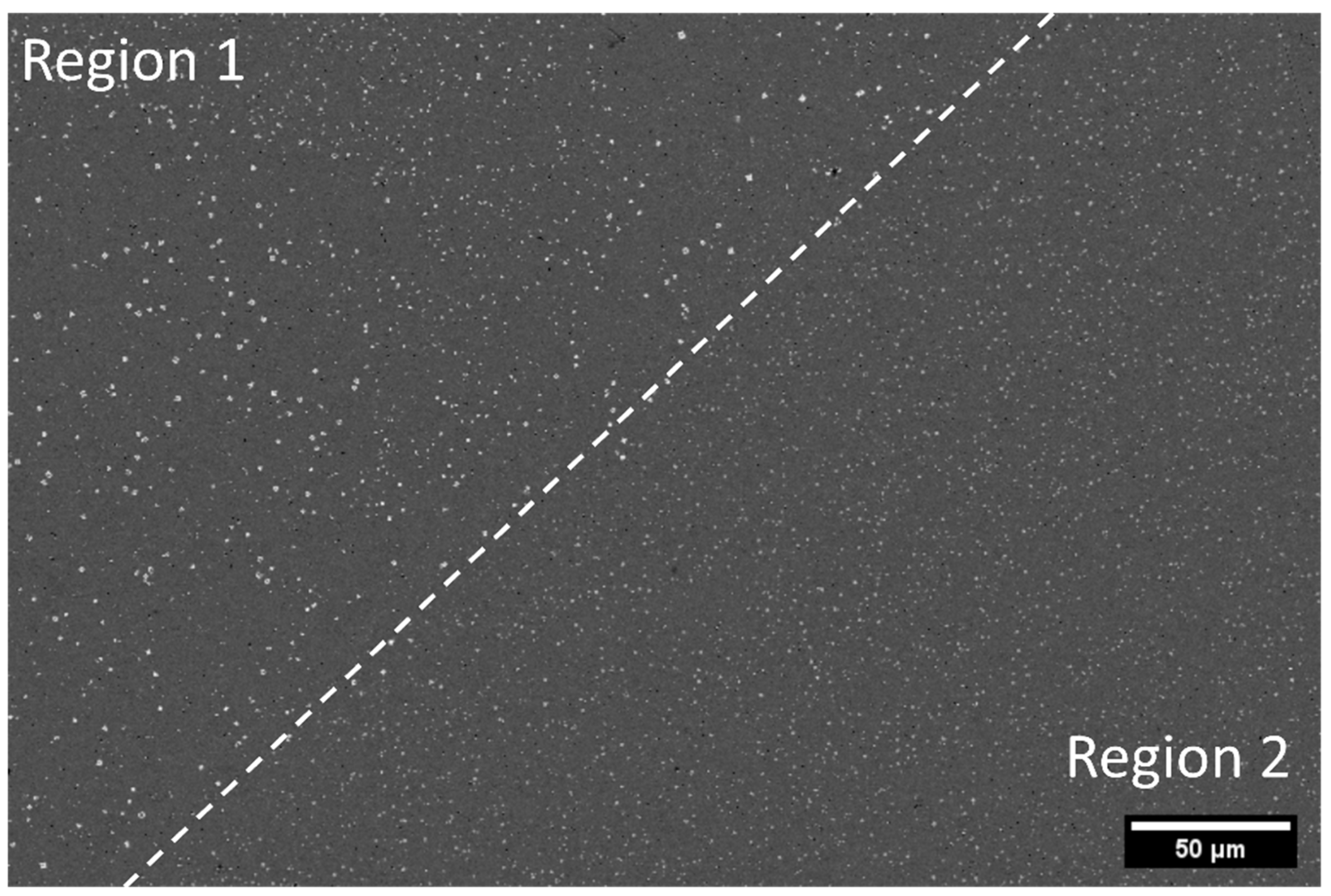
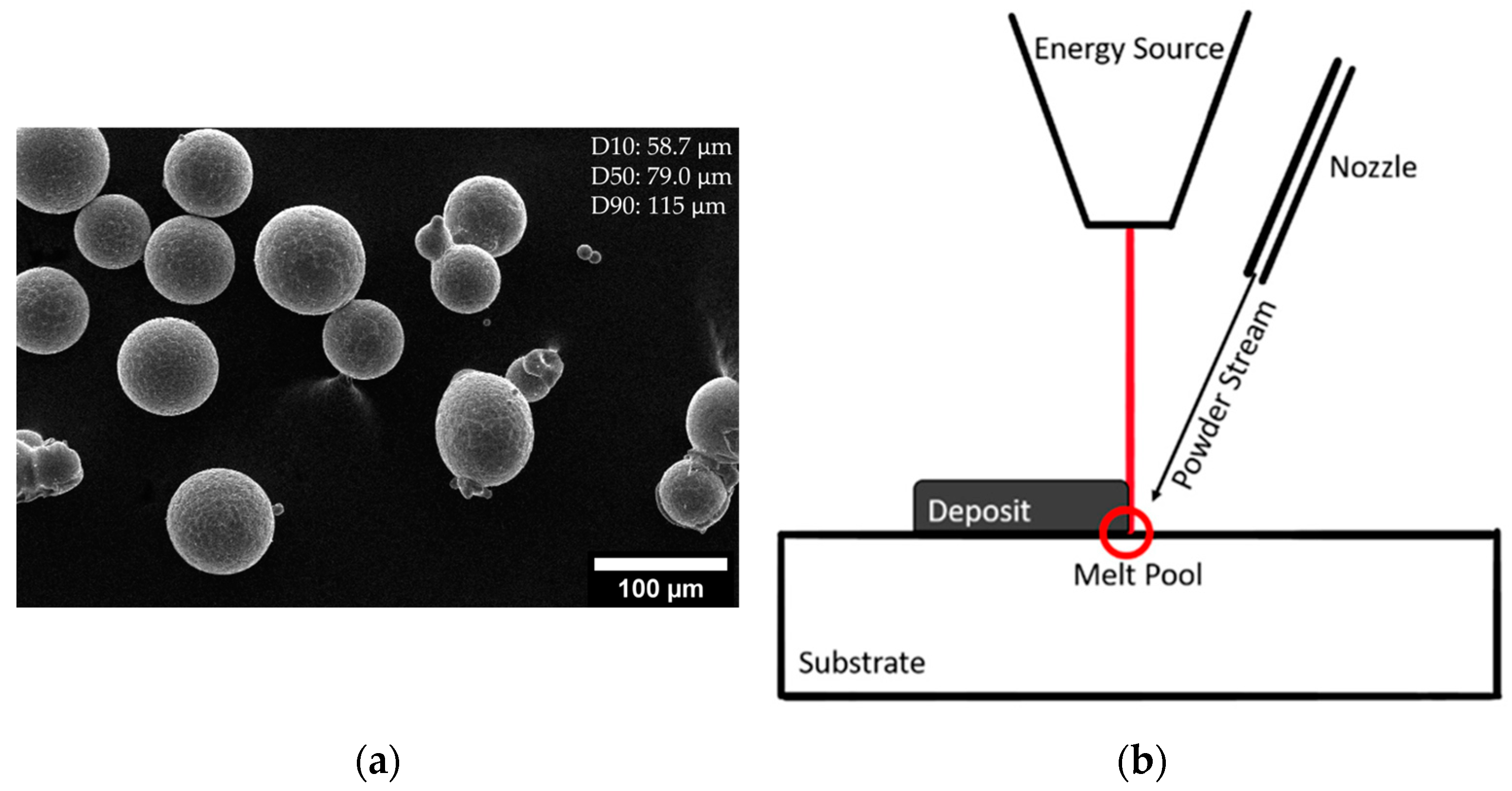
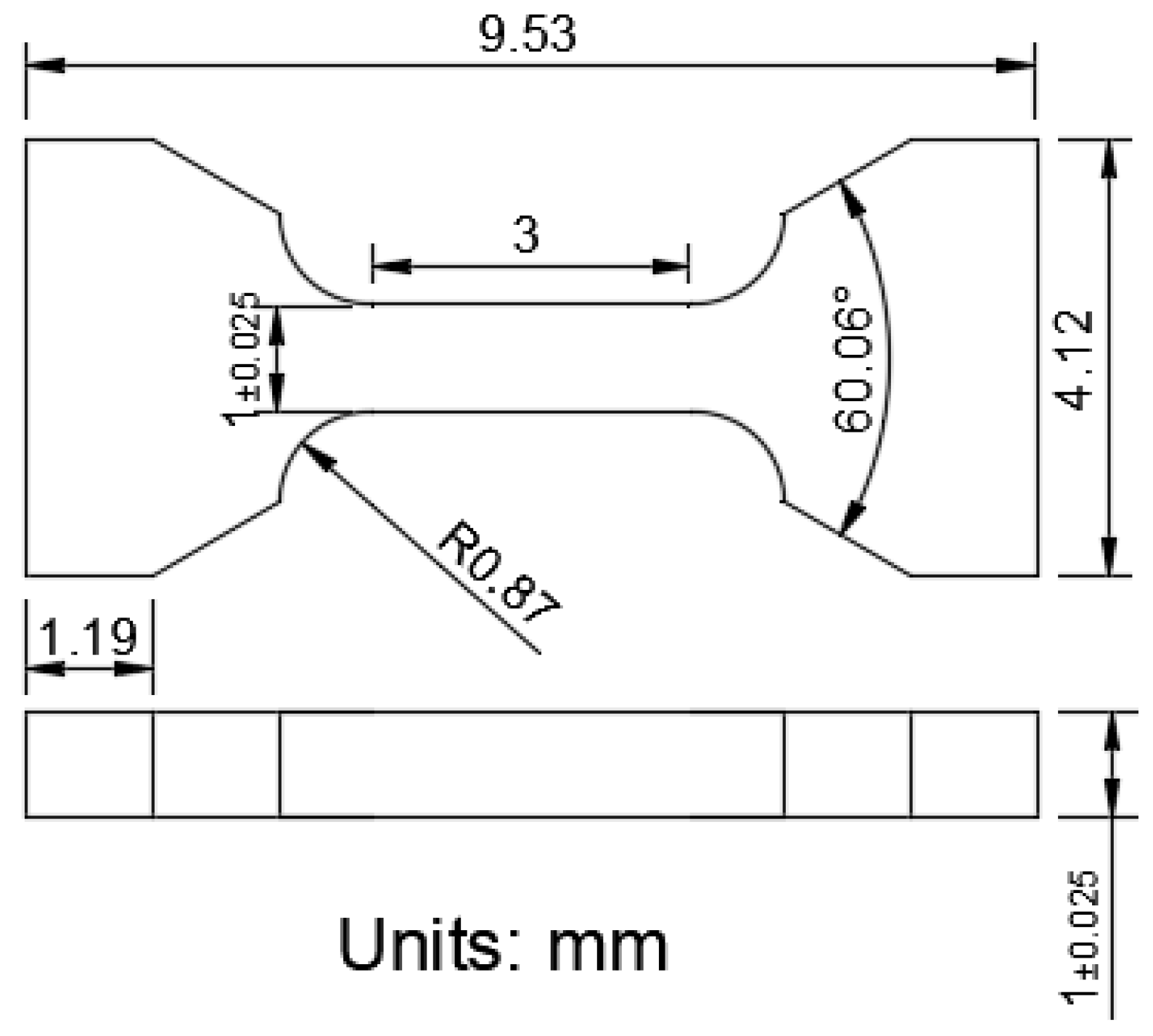
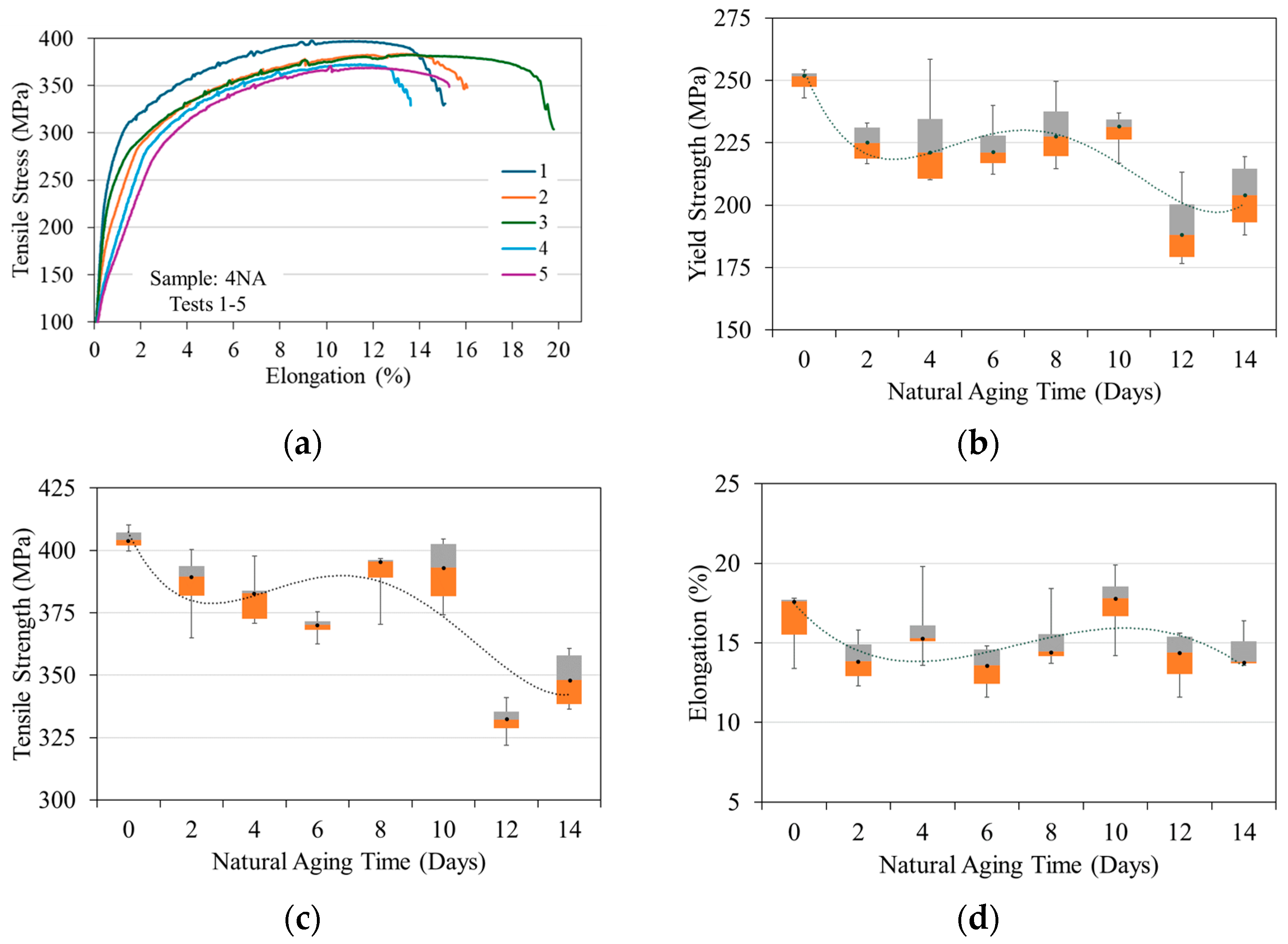

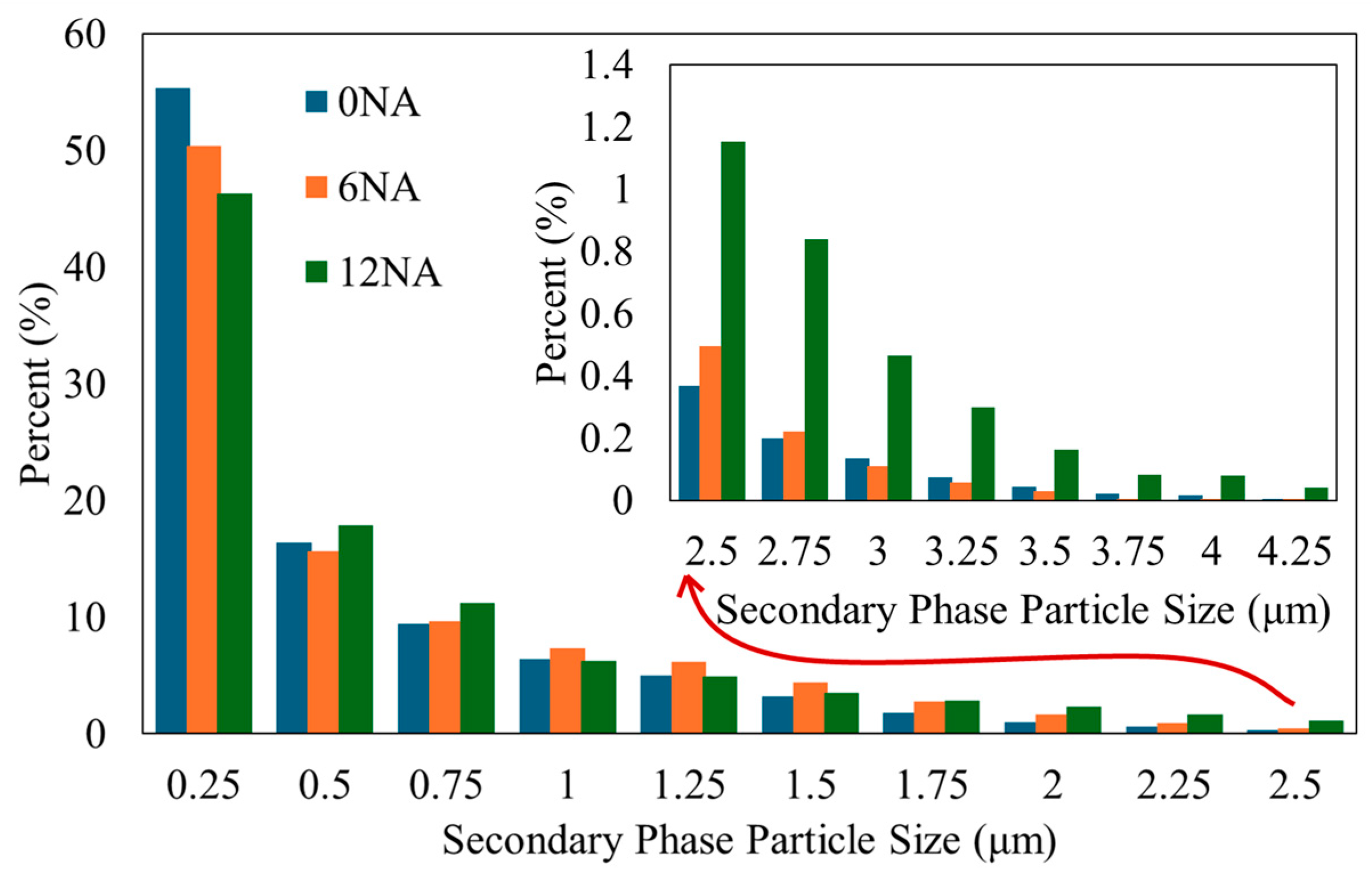
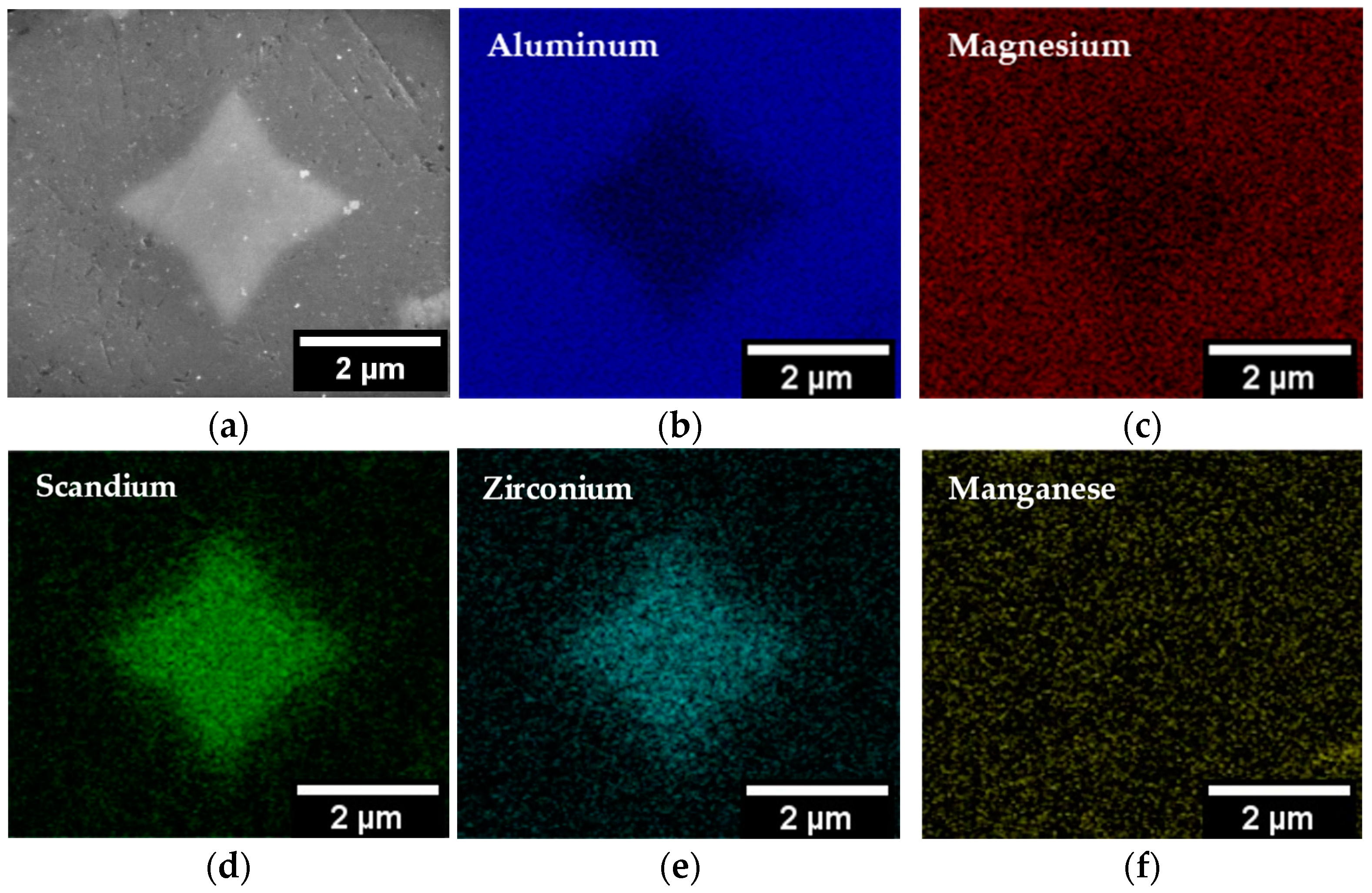


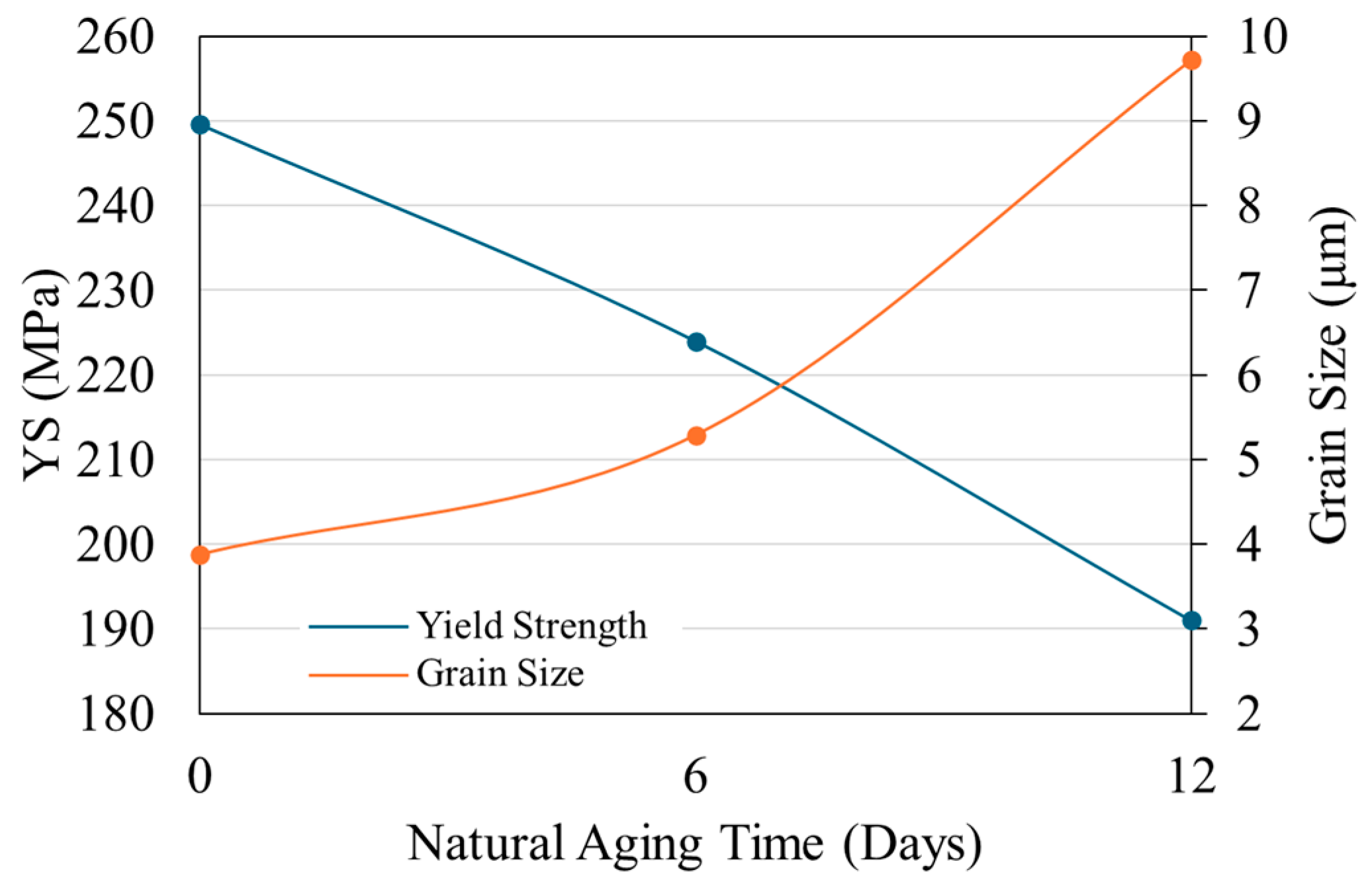
| Element | Specification (wt%) | Actual (wt%) |
|---|---|---|
| Magnesium | 4.5–4.9 | 4.7 |
| Scandium | 0.68–0.78 | 0.73 |
| Zirconium | 0.2–0.4 | 0.33 |
| Manganese | 0.2–0.7 | 0.56 |
| Iron | ≤0.2 | 0.09 |
| Silicon | ≤0.2 | 0.08 |
| Titanium | ≤0.15 | 0.08 |
| Aluminum | Balance | Balance |
| Parameters | Values |
|---|---|
| Power (W) | 1625 |
| Scan Speed (mm/s) | 15 |
| Powder Feed Rate (g/min) | 2.25 |
| Specimen ID | Natural Aging (Days) | Artificial Aging |
|---|---|---|
| 0 NA | 0 | 325 °C @ 4 h |
| 2 NA | 2 | |
| 4 NA | 4 | |
| 6 NA | 6 | |
| 8 NA | 8 | |
| 10 NA | 10 | |
| 12 NA | 12 | |
| 14 NA | 14 |
| Sample | Median Feret Diameter (μm) | Range (μm) | Area (%) |
|---|---|---|---|
| 0 NA | 0.17 | 5.1 | 5.1 |
| 6 NA | 0.17 | 4.5 | 4.0 |
| 12 NA | 0.27 | 5.0 | 2.7 |
| Sample | Sample Location | Figure 9 ID | Area Weighted Mean Grain Size (μm) | Maximum Grain Size (μm) |
|---|---|---|---|---|
| 0 NA | 1 | A | 3.9 ± 1.4 | 8.7 |
| 2 | 4.1 ± 1.4 | 7.9 | ||
| 3 | 3.8 ± 1.3 | 7.3 | ||
| 6 NA | 1 | B | 4.6 ± 1.7 | 9.0 |
| 2 | 4.8 ± 1.7 | 10 | ||
| 3 | 6.4 ± 2.3 | 13 | ||
| 12 NA | 1 | C | 9.4 ± 3.7 | 18 |
| 2 | 8.9 ± 3.4 | 20 | ||
| 3 | 11 ± 4.3 | 22 |
Disclaimer/Publisher’s Note: The statements, opinions and data contained in all publications are solely those of the individual author(s) and contributor(s) and not of MDPI and/or the editor(s). MDPI and/or the editor(s) disclaim responsibility for any injury to people or property resulting from any ideas, methods, instructions or products referred to in the content. |
© 2025 by the authors. Licensee MDPI, Basel, Switzerland. This article is an open access article distributed under the terms and conditions of the Creative Commons Attribution (CC BY) license (https://creativecommons.org/licenses/by/4.0/).
Share and Cite
Boillat-Newport, R.; Isanaka, S.P.; Liou, F. Impact of Delayed Artificial Aging on Tensile Properties and Microstructural Evolution of Directed Energy Deposited Scalmalloy®. Appl. Sci. 2025, 15, 3674. https://doi.org/10.3390/app15073674
Boillat-Newport R, Isanaka SP, Liou F. Impact of Delayed Artificial Aging on Tensile Properties and Microstructural Evolution of Directed Energy Deposited Scalmalloy®. Applied Sciences. 2025; 15(7):3674. https://doi.org/10.3390/app15073674
Chicago/Turabian StyleBoillat-Newport, Rachel, Sriram Praneeth Isanaka, and Frank Liou. 2025. "Impact of Delayed Artificial Aging on Tensile Properties and Microstructural Evolution of Directed Energy Deposited Scalmalloy®" Applied Sciences 15, no. 7: 3674. https://doi.org/10.3390/app15073674
APA StyleBoillat-Newport, R., Isanaka, S. P., & Liou, F. (2025). Impact of Delayed Artificial Aging on Tensile Properties and Microstructural Evolution of Directed Energy Deposited Scalmalloy®. Applied Sciences, 15(7), 3674. https://doi.org/10.3390/app15073674







